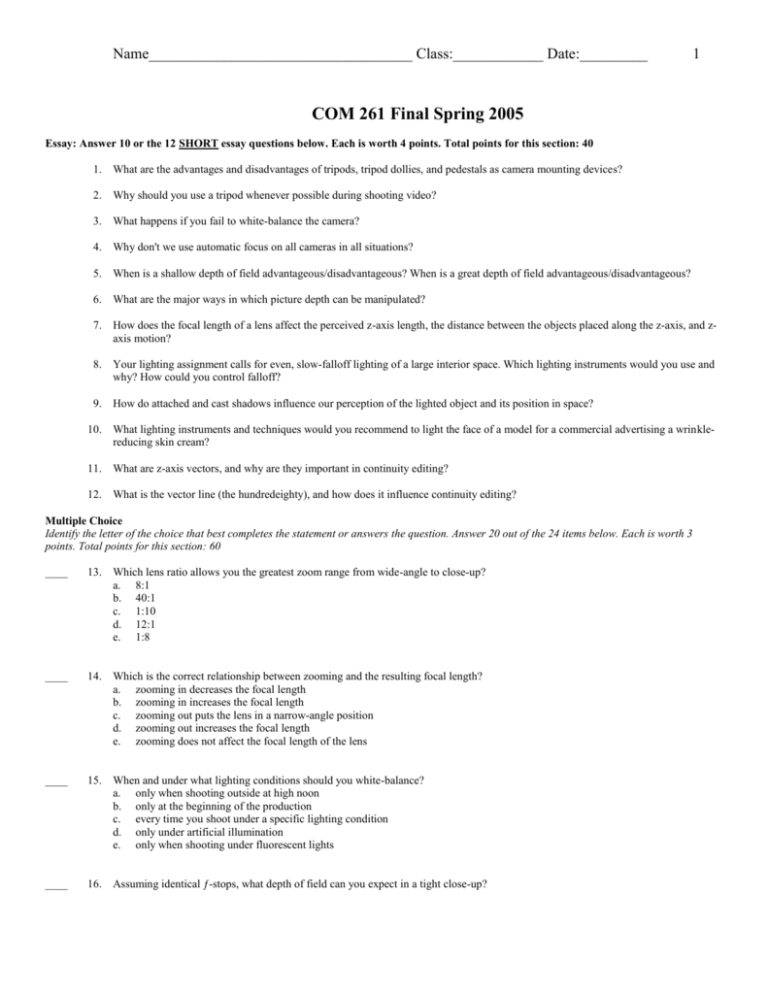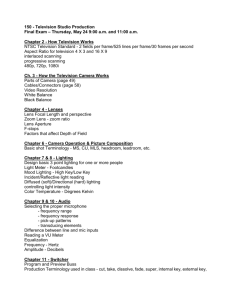COM 261 Final Spring 2005
advertisement

Name___________________________________ Class:____________ Date:_________ 1 COM 261 Final Spring 2005 Essay: Answer 10 or the 12 SHORT essay questions below. Each is worth 4 points. Total points for this section: 40 1. What are the advantages and disadvantages of tripods, tripod dollies, and pedestals as camera mounting devices? 2. Why should you use a tripod whenever possible during shooting video? 3. What happens if you fail to white-balance the camera? 4. Why don't we use automatic focus on all cameras in all situations? 5. When is a shallow depth of field advantageous/disadvantageous? When is a great depth of field advantageous/disadvantageous? 6. What are the major ways in which picture depth can be manipulated? 7. How does the focal length of a lens affect the perceived z-axis length, the distance between the objects placed along the z-axis, and zaxis motion? 8. Your lighting assignment calls for even, slow-falloff lighting of a large interior space. Which lighting instruments would you use and why? How could you control falloff? 9. How do attached and cast shadows influence our perception of the lighted object and its position in space? 10. What lighting instruments and techniques would you recommend to light the face of a model for a commercial advertising a wrinklereducing skin cream? 11. What are z-axis vectors, and why are they important in continuity editing? 12. What is the vector line (the hundredeighty), and how does it influence continuity editing? Multiple Choice Identify the letter of the choice that best completes the statement or answers the question. Answer 20 out of the 24 items below. Each is worth 3 points. Total points for this section: 60 ____ 13. Which lens ratio allows you the greatest zoom range from wide-angle to close-up? a. 8:1 b. 40:1 c. 1:10 d. 12:1 e. 1:8 ____ 14. Which is the correct relationship between zooming and the resulting focal length? a. zooming in decreases the focal length b. zooming in increases the focal length c. zooming out puts the lens in a narrow-angle position d. zooming out increases the focal length e. zooming does not affect the focal length of the lens ____ 15. When and under what lighting conditions should you white-balance? a. only when shooting outside at high noon b. only at the beginning of the production c. every time you shoot under a specific lighting condition d. only under artificial illumination e. only when shooting under fluorescent lights ____ 16. Assuming identical ƒ-stops, what depth of field can you expect in a tight close-up? Name___________________________________ Class:____________ Date:_________ a. b. c. d. e. 2 great shallow wide narrow horizontal ____ 17. What tripod mechanism facilitates the quick and accurate mounting of the camcorder? a. fluid head b. cam head c. quick-release plate d. fast-mount e. mount facilitator ____ 18. Which is the most common way of handling camera and object movement? a. keep the camera as steady as possible and have the object do the moving b. have the camera do most of the moving c. have the object as stationary as possible and zoom rapidly in and out d. have the camera move while zooming slowly in and out e. slow down object movement while speeding up camera movement ____ 19. Which way should the camera point and which zoom lens position should you use to intensify the congestion and slowness of rushhour traffic? a. x-axis and wide-angle lens b. x-axis and narrow-angle lens c. z-axis and wide-angle lens d. z-axis and narrow-angle lens e. wide-angle lens and switch from z-axis to x-axis ____ 20. What is the most appropriate definition of field of view? a. a clear and unobstructed vista b. the view you get when operating an ENG/EFP camera in the field c. the strict observance of compositional principles d. how close or far away the object appears relative to the camera e. the number of people or objects that appear in a shot ____ 21. When do you need to leave leadroom? a. when the object moves up and down b. when the object moves toward the camera c. when the object moves away from the camera d. when zooming in and out e. when the object moves sideways ____ 22. What statement applies to proper z-axis blocking? a. objects and people are positioned along the screen width b. objects and people are positioned in a triangular fashion c. objects and people are positioned on the line that extends from the camera to the horizon d. objects and people must be lined up in a zigzag (z) fashion e. objects and people do not block each other's view ____ 23. Why should you leave headroom? a. to counter the magnetic pull of the bottom screen edge b. to neutralize the force of the index vectors c. to neutralize the graphic vectors d. to neutralize the motion vectors e. to counter the magnetic pull of the top screen edge Name___________________________________ Class:____________ Date:_________ ____ 24. What is the relationship among focal length, depth of field, and focus? a. the shorter the focal length (wider angle) of the lens, the shallower the depth of field and more of the z-axis is in focus b. the shorter the focal length (wider angle) of the lens, the greater the depth of field and more of the z-axis is in focus c. the longer the focal length (narrow angle) of the lens, the shallower the depth of field and more of the z-axis is in focus d. the longer the focal length (narrow angle) of the lens, the greater the depth of field and less of the z-axis is in focus e. the wider the lens, the greater the depth of field and less of the z-axis is in focus ____ 25. What is the difference between an over-the-shoulder shot and a cross-shot? a. the over-the-shoulder shot is taken from the camera operator's shoulder b. the cross-shot is taken from both sides of the scene c. in a cross-shot, only the camera-far person is in the shot d. in a cross-shot, only the camera-near person is in the shot e. in the over-the-shoulder shot, only the camera-near person is in the shot ____ 26. What are the light primaries used in additive color mixing? a. red, blue, yellow b. red, green, yellow c. red, cyan, magenta d. magenta, cyan, yellow e. red, green, blue ____ 27. Which statement describes color temperature? a. how hot a lamp feels when you touch it b. the lighting instrument used c. the heat reaching the color gel in front of the lens d. the relative reddishness or bluishness of the light e. how much colored light is concentrated on the subject ____ 28. What combination of color temperatures is correct for the indoor and outdoor standards, respectively? a. 3,200K and 5,600K b. 3,000K and 5,600K c. 5,500K and 3,200K d. 5,600K and 3,200K e. 3,600K and 5,000K ____ 29. What is the basic function of the key light? a. soften shadows created by the back light b. provide a strong light opposite the kicker c. reveal the basic shape of the subject d. add sparkle to the subject's eyes e. silhouette the subject ____ 30. What is the best light for shooting outdoors during the day? a. sunlight coming from the back b. sunlight at noon c. sunlight coming from the front d. sunlight in the morning e. overcast day 3 Name___________________________________ Class:____________ Date:_________ ____ 31. Which combination matches the normal lighting triangle? a. key, back, background b. side, back, key c. fill, back, side d. background, side, key e. key, back, fill ____ 32. Which microphone type is the most rugged? a. ribbon b. dynamic c. condenser d. cardioid e. shotgun ____ 33. In the context of microphone characteristics, cardioid refers to: a. the heart condition of the audio engineer b. a specific omnidirectional polar pattern c. a specific unidirectional polar pattern d. a special sound-generating device e. a specific microphone application ____ 34. What is the optimal VU range when riding gain? a. -5 to 0 VU b. between -20 and -7 VU c. 0 to +3 VU d. -20 to +3 VU e. 0 to 100 percent ____ 35. What is a jump cut? a. somebody suddenly jumping up during a cut b. somebody jumping out of the frame c. an abrupt position change of an object or subject from one shot to another d. showing a different angle of an object in subsequent shots in complexity editing e. showing a different field of view in subsequent shots in complexity editing ____ 36. What statement best describes crossing the vector line while shooting an over-the-shoulder conversation? a. you reverse the screen positions of the people b. you change the field of view c. you provide good shot continuity d. you will emphasize the camera-near person e. you will emphasize the person facing the camera 4








